This was published 2 years ago
Access all areas: the Australian photographer celebrities embraced
By Lee Tulloch
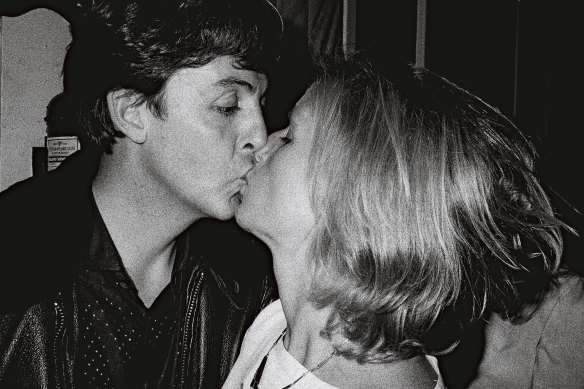
Paul and Linda McCartney, Abbey Road Studios, London, 1982Credit: Robert Rosen
Visitors to the retrospective of social photographer Robert Rosen’s 40-year career at the Powerhouse , will be greeted by a “kissing wall” made up of hundreds of photographs of people brushing lips and cheeks, among them international celebrities, fashion stars and stalwarts of London and Sydney’s social scenes.
In an era where even the casual air kiss is frowned upon, this exuberant sharing of close personal space might seem a bit jarring. But for Rosen, whose favourite photo in his archive is Paul and Linda McCartney smooching in London in 1982, the kiss was the point of entry to a world of parties and privilege, which Rosen made his beat after he fast-talked his way into a job as official photographer for London VIP hangout The Embassy Club in the mid-1970s.
Unassuming, respectful of his subjects, and discreet in his approach, with a little “snappy” camera tucked in a pocket rather than around his neck, Rosen was a ubiquitous face at parties and fashion shows in London, Paris and Sydney until he decamped to Bali in 2012, where he now lives in splendid retirement in the pink-painted Villa Lotus, which he built in Seminyak.
Over the course of a long career, Rosen followed the advice given him by filmmaker Paul Cox, his photography teacher at Prahran Technical College in the 1970s – never throw a negative away. When he moved to Bali, he faced the dilemma of what to do with his copious and fragile archive, which would disintegrate in Bali’s heat, so he donated the work to the Powerhouse. Those negatives, prints, polaroids and ephemera, such as fashion show invitations and lanyards, as well as detailed illustrated diaries of his social life, form the basis of the museum’s Robert Rosen archive and this year’s retrospective. Rosen, 68, is a bit bemused at the prospect. “I thought I had to be dead for them to do it.”
Speaking from Bali, Rosen reminisces about the life he has left behind. “I lived and breathed it – and drank it,” he says with a chuckle. But to think of him as a party boy would be a mistake. In the pre-digital days in London, when he was working for seven magazines simultaneously, he’d run from event to event and then to his darkroom over a pornographic bookstore in Notting Hill to print his shots for a morning deadline. Those who know him in Sydney know that beneath a quicksilver, almost fey, exterior was a tireless professional with the stamina of the Energizer Bunny. (He happens to like rabbits.)
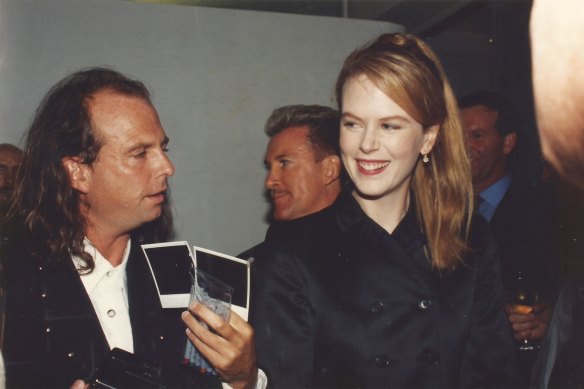
Photographer Robert Rosen shows Nicole Kidman the Polaroids he has taken of her (Sydney, 1996).
Rosen’s fascination with glamour began as early as the age of 10. With his family, parents, Natalie and Niel and younger sister Sarion, he emigrated from Cape Town in 1960 to suburban Melbourne, where his father found a job with Myer as a sales manager. Frequently bored, the young Robert would hang out in the local newsagencies, lured by the celebrity magazines. Saving up his pocket money to buy pop culture magazine Everybody’s, he’d tear out the pages to stick all over his walls. “The first time I did it, Mum came into the room and said, ‘Well you can’t have these two up there’. One was Hitler and the other one was Christine Keeler. I had no idea who they were!”
His father gave him a Box Brownie camera, but it wasn’t until he went to Melbourne Boys High in the mid 1960s, and his art teacher handed him an Asahi Pentax camera, that he became interested in photography. He applied for a place in the photography course at Prahran Technical College and the head of the school, legendary fashion photographer Athol Shmith, was so impressed with his portfolio that he placed him immediately in first year without having to do the preliminary year.
Despite having Paul Cox as his mentor, Rosen didn’t stay the course. “I loved Salvador Dali, so I was doing surreal photographs and montages, collages, and we would have marking every month. All the photos would go up on a board and all the teachers would be there. One of the teachers, every month, would say, ‘Oh God, this has to be Robert Rosen’s’, because it was so different from everybody else, and weird.”
In one dispiriting exchange, a teacher told him that he wouldn’t make it as a photographer unless he became more commercial. “I was not going to change my style for anybody. So I just said, ‘Well, f--- you, I’m leaving.’ And I did. I walked straight out of that room and I never went back.”
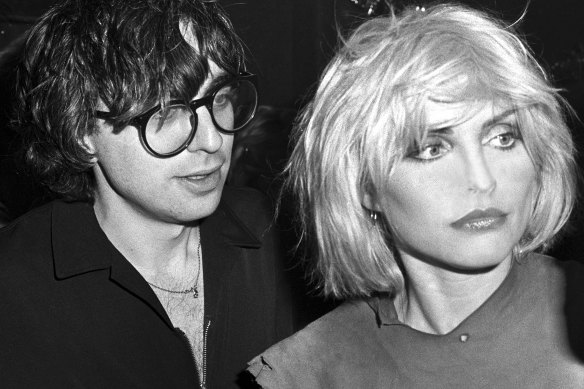
Chris Stein and Debbie Harry (London, 1979).Credit: Robert Rosen
He hitchhiked to Sydney, where he lived among the city’s demi-monde in the Kings Cross area. “I felt at home amongst all the freaks because they were all artistic; they were all either young fashion designers, painters, sculptors or filmmakers. There were lots of incredible fancy-dress parties. I loved that lifestyle; it was great. But I don’t know how we lived. We were all on the dole. None of us really had proper jobs, but we survived.”
He found a job at the telephone exchange and would chat long distance to makeup artist Richard Sharah, who was living in London. Encouraged by Sharah, he saved up and moved into Sharah’s London mansion flat in 1975, sleeping in the kitchen for a while. There he met Australian rock journalist Cherry Ripe, who would take him to concerts. Together they sold words and pictures to music publications. But it was tough to make ends meet, so Rosen returned to Australia after eight months and went back to the telephone exchange, taking photographs in his spare time and having them occasionally published in magazines such as POL.
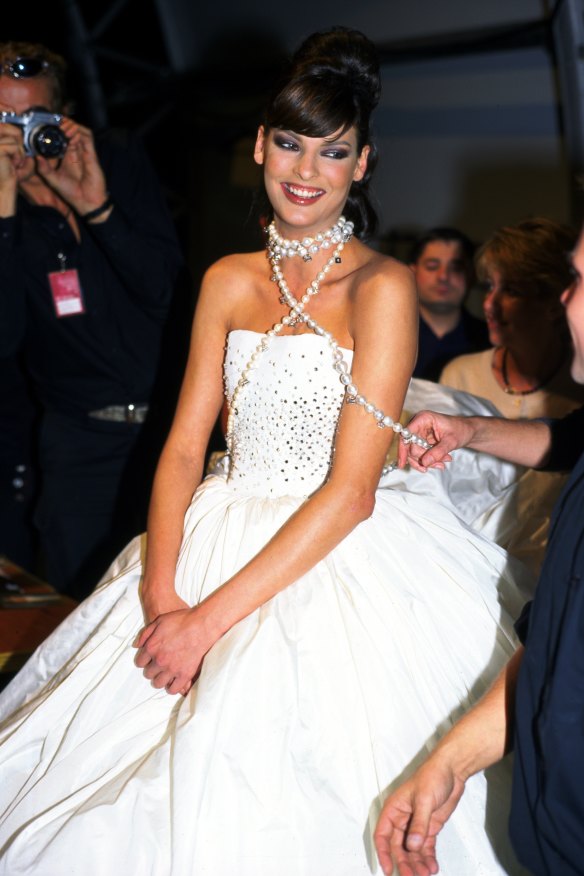
Linda Evangelista models Alex Perry Spring/Summer 1997 at Australian Fashion Week.Credit: Robert Rosen
In 1978 he met British socialite Neelia Winn in Sydney and moved back to London with her. Her house was on Cheyne Walk, in fashionable Chelsea. “Mick and Bianca were down the road. Marianne lived around the corner.” Rosen says Winn “seemed to be on every guest list because she was somebody fabulous, so we go for dinner in swish restaurants, and then we would go to the nightclubs after, like the Embassy Club and Legends and Tramp”.
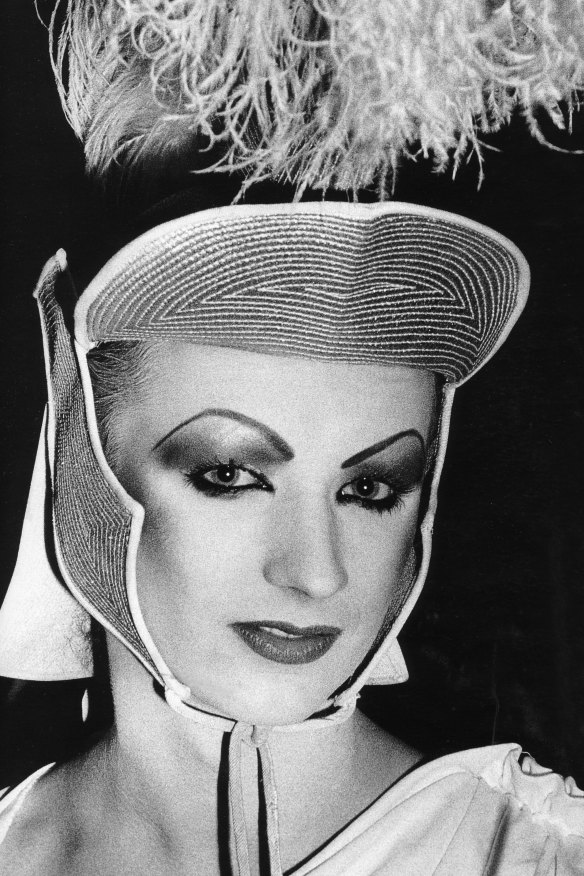
Boy George at the Embassy Club (London, 1979).Credit: Robert Rosen
Rosen noticed there were paparazzi there every night, so he asked one of them what he was doing. The photographer explained he was taking photos to sell to the newspapers. “And I went ding! ca-ching! Really?” Rosen started bringing a camera along to the parties. One night he took a photo of Bryan Ferry and called a newspaper. They were interested. “That’s how I started.”
Soon he had talked his way into being the official photographer for the Embassy Club in Mayfair, London’s Studio 54. He gave the club prints in return for access to the VIP areas and champagne in the bar. The security guards and the celebrities got to know him. One of the things he worked out early on was to dress as if he were a guest at the parties. Kitted out in designer suits and Andrew Logan mirror brooches, he looked unlike the other members of the press pack.
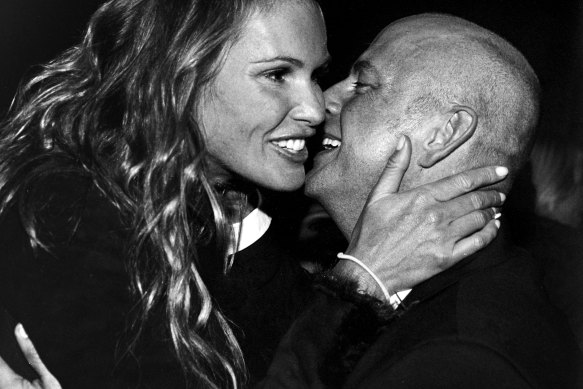
Elle Macpherson and Peter Morrissey at his party during Mercedes Fashion Week (Sydney 2005).Credit: Robert Rosen
“If it was a premiere, I would dress in black tie because I knew everybody else would be.” When the photography session was over and the paparazzi asked to leave, “I would put the camera into my pocket, grab a glass of champagne and disappear into the crowd. The PR wouldn’t notice, they were so busy. Then after about an hour, when everyone’s jolly, I’d take my camera out and I’d get more photos. The stars thought I was one of the guests.” Eventually they trusted him. “I’ve never published a bad photo of anybody,” he says. Over the years Rosen has taken pains not to be associated with the paparazzi. “I wouldn’t like to be stalked and I wouldn’t stalk anybody.”
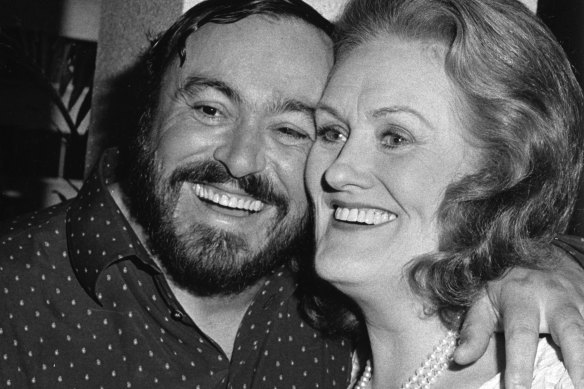
Luciano Pavarotti and Dame Joan Sutherland at the Regent Hotel (Sydney, 1983).Credit: Robert Rosen
He took the photo of Paul and Linda McCartney’s kiss at a party at Abbey Road. He sold the photo around the world and, to thank them, sent a print. “Six months later I’m walking down Dover Street to an art gallery opening and I see Paul and Linda walking into the gallery as well. I thought, they’re not going to remember me, so I walked straight past them. And then I hear this whistle, someone putting their fingers in their mouth. ‘Aye, are you ignoring us?’ It was Linda. I turned around and said, ‘Sorry, I thought you wouldn’t remember me’ and she said, ‘What? We love that picture. Darling, give me a hug.’ That was better than any money I got.”
‘I’ve never published a bad photo of anybody ... I wouldn’t like to be stalked and I wouldn’t stalk anybody.’
Robert Rosen on the paparazzi
At The Embassy Club he met legendary fashion publicist Lynne Franks (famously the inspiration for Edina in Absolutely Fabulous) who was just starting London Fashion Week. She asked Rosen if he’d like to record the shows. He jumped at the opportunity. “All the young designers who became famous were just starting then.” Soon he was shooting for numerous magazines, including Ritz, Avant-Garde and Fashion Weekly.
“The late ’70 and ‘80s in London and around the world was the best period for photography because the fashions were fantastic,” he says. “There was Punk, Neo Romantic, Sharpies – all the different styles of people that were just extraordinary. Especially the shoulder pad, which I love – the big shoulder pads of the ’80s, the big hair and the coloured hair.”
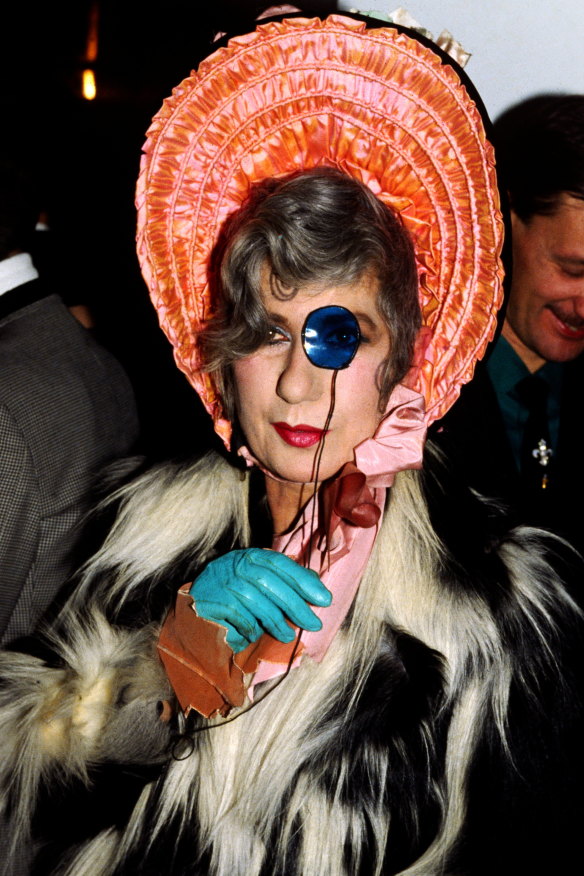
Vogue Italia’s legendary Anna Piaggi (London, 1986).Credit: Robert Rosen
Rosen would return to Australia each summer. “I was still living pretty much in poverty in England,” he says. This is where I come into the picture. In 1984, I was starting up the first Australian edition of Harper’s Bazaar and asked Robert, on one of his visits, if he’d like to do the social pages for the magazine and have his own page too, where he would photograph Australia’s most stylish avant-garde. Several of these portraits, including cabaret artist Simon Reptile and Rosen’s friend, rock singer Michael Hutchence, appear in the Powerhouse retrospective.
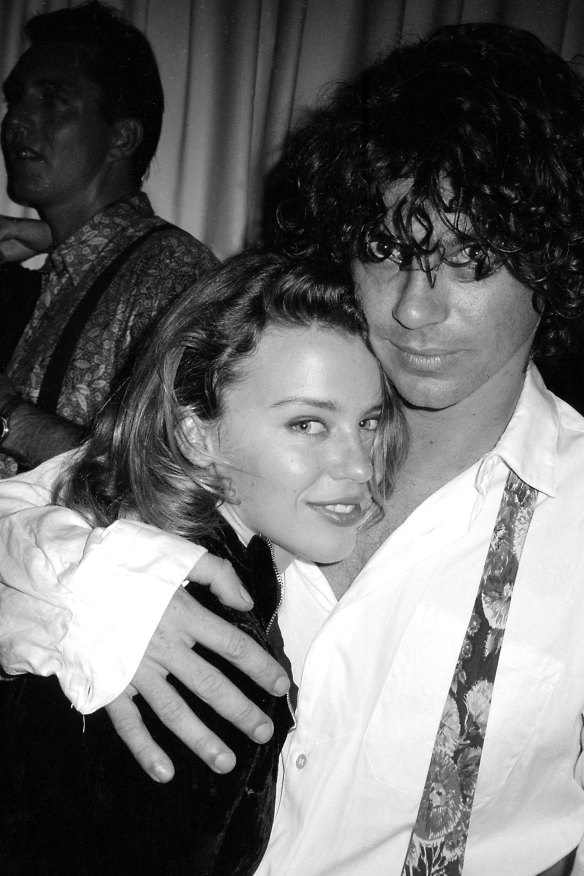
Kylie Minogue and Michael Hutchence at his 30th birthday party in Sydney, 1990.Credit: Robert Rosen
In the years that followed, Rosen would establish himself as Vogue’s social photographer and work regularly for Elle, Mode, The Sydney Morning Herald and The Sunday Telegraph. When Australian Fashion Week began in 1996, Jackie Frank, editor of Marie Claire, commissioned him to cover the shows from a backstage perspective. “I loved backstage,” he says. “It was so exciting – the designers screaming ‘where are the shoes?’, ‘the models screaming ‘you’ve ruined my hair’.”
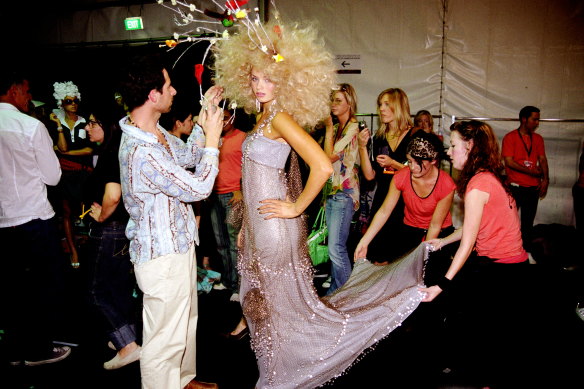
Backstage at the Leona Edmiston Spring/Summer 2005-06 Mercedes Fashion Week, Sydney.Credit: Robert Rosen
The torrent of images were exhibited in 24 solo shows between 1979 and 2018. While he has officially “retired” from the social whirl, Rosen hasn’t retired the snappy camera. In Bali, he has held exhibitions of his work to raise funds for Balinese orphans. The Robert Rosen Arts Foundation recently sent a talented young boy from a small village to university to study architecture.
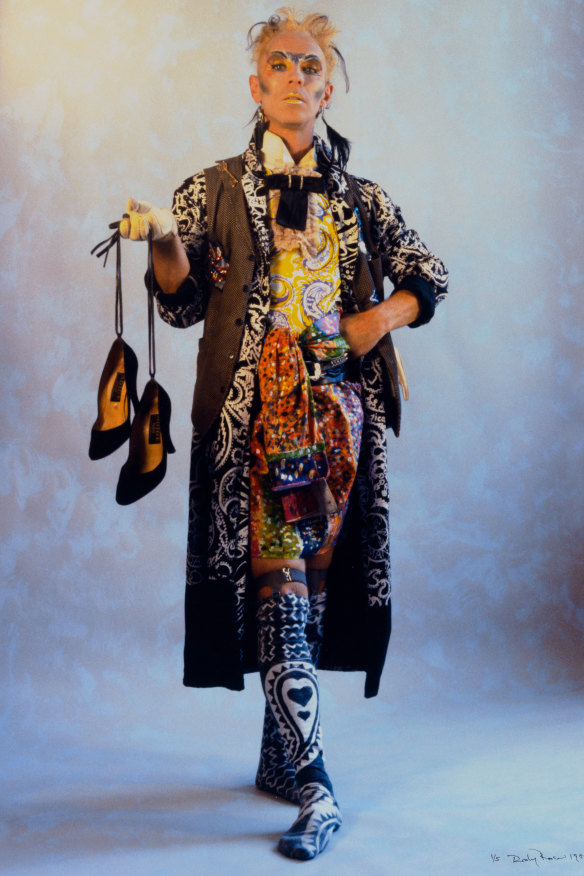
Simon Reptile, photographed for Harper’s Bazaar Australia in 1985.Credit: Robert Rosen
The changing face of magazines and the corporatisation of fashion and events means he has no regrets in closing that chapter of his life. And then there are the “bloody” phones. “I’d ask two people at a party, ‘Can I take a shot of you?’ and I’d lift the camera to take it and one of the guests would stand in front of me with their mobile phone. Once I kicked someone in the leg and said, ‘Get out’!”
Ironically, COVID-19 restrictions meant he couldn’t come to Sydney for the opening of his show (which was first scheduled to start in early August with a big party). “The exhibition means everything to me,” he says. “It brings a tear to my eye that I have accomplished something in my life. I remember Dad saying, even when I was working for Vogue, and I’m about 30, he’d say, ‘Robert, when are you going to get a proper job’?”
Robert Rosen: Glitterati will run until April 25, 2022 at The Powerhouse Museum, Ultimo, Sydney. maas.museum/powerhouse-museum
Find out the next TV, streaming series and movies to add to your must-sees. Get The Watchlist delivered every Thursday.